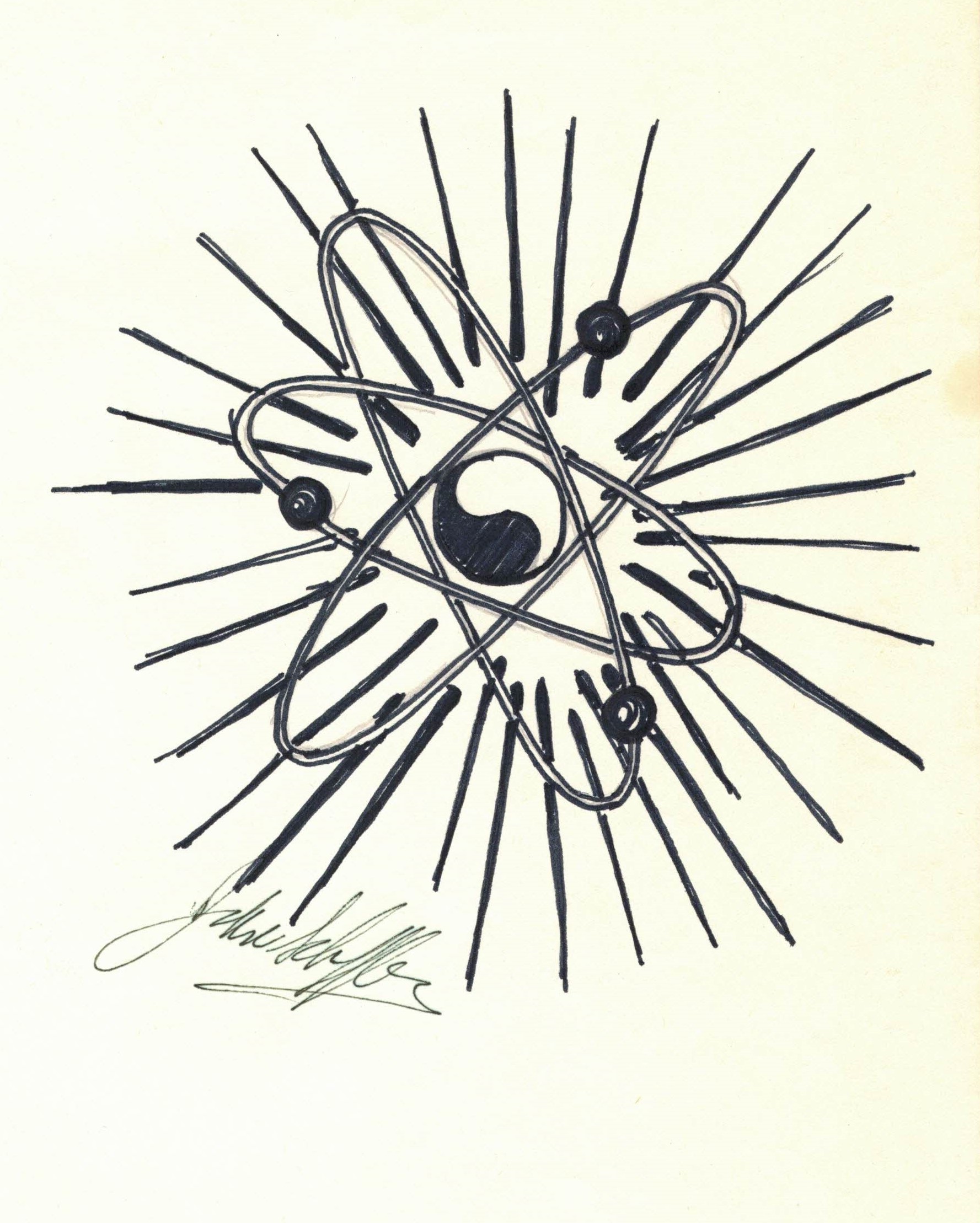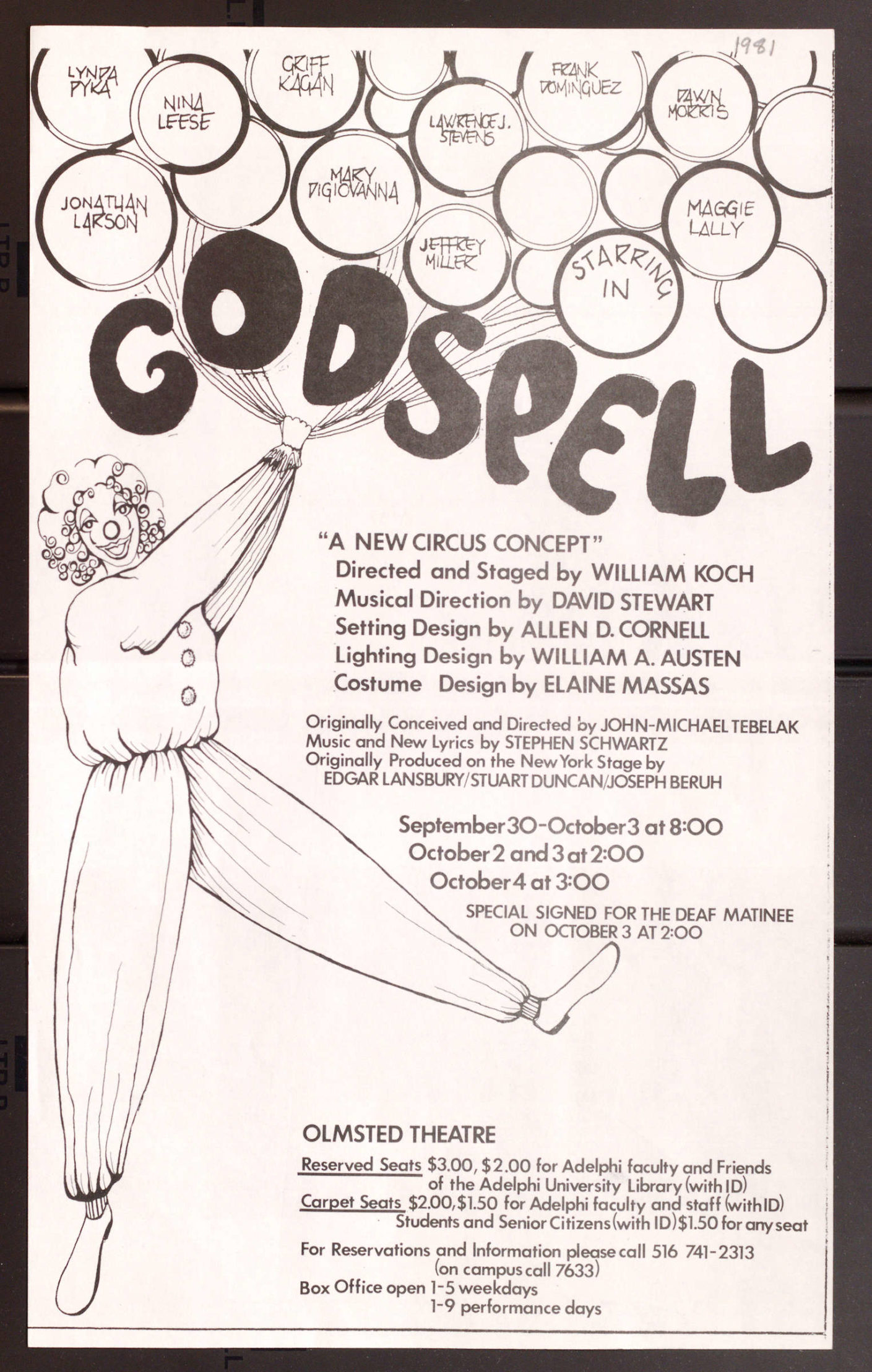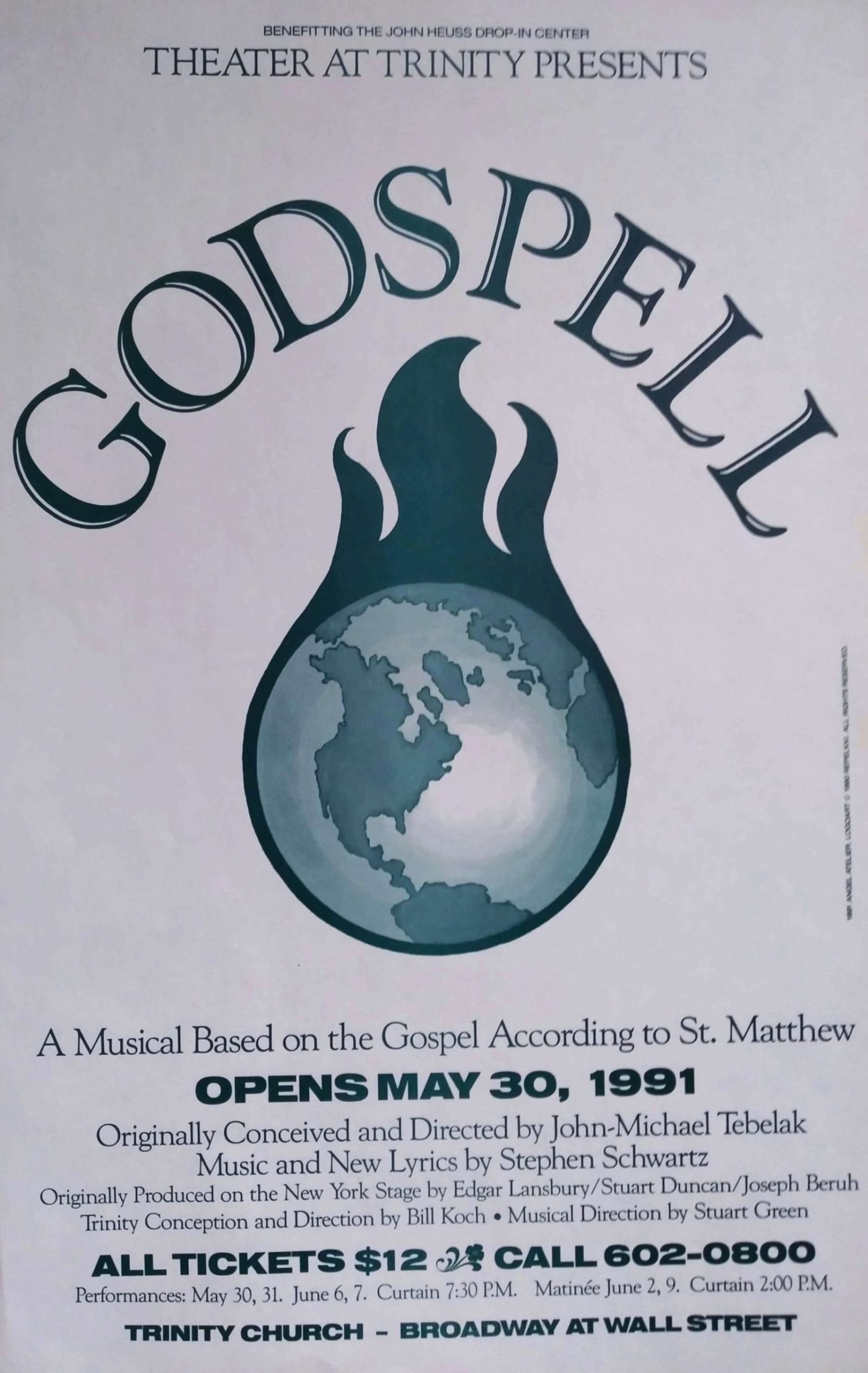


GODSPELL — Theatre (1981)
for Equity Library Theater, NYC
RESEARCH/The 4 Gospels & The Script:
Five years after the success of MAGGIE FLYNN, I was invited to Stage Direct & Choreograph my second show for Equity Library Theater: John-Michael Tebelak & Stephen Schwartz’s GODSPELL. I was thrilled, having seen and enjoyed the original production Off-Broadway. My mentor Ralph Haugen had taught me to always investigate the original source when directing an adaptation, so (though I wanted no connection with religion at the time) I sat down and read the Gospels of Matthew, Mark, Luke, and John. Surprisingly, it was my first sense of this spiritual man Jesus of Nazareth different from modern Christianity. And I quickly realized that this spiritual leader taught the same kind of principles my Theatre mentor Ralph had taught me about producing good Theatre.
JOHN-MICHAEL TEBELAK
My concept came quickly, and producer George Wojtusik encouraged me to call John-Michael Tebelak and ask his permission to visually translate the show. Rather than its original circus theme, my concept was that the cast were a group of “in-between-shows” actors in an empty theater. John-Michael loved this idea and commended me for wanting to make the show more connecting with my Theatre audience now, sharing how he had written the original to share his spiritual beliefs with his fellow students at Carnegie-Mellon University. Later, he came to see our production (bringing us his traditional bunch of colored balloons!) and was thrilled and joyed by our presentation, highly praising me, our incredible cast, staff, and crew,
AUDITIONS
I almost always ask performers to do improv in call backs because it reveals so much about them as persons as well as actors—and most people have fun! So all finalists were called to a group afternoon (re ensemble requirements of the show) and they were told the cast would be announced at the end of the callbacks. Two favorite memories:
“Day By Day”—There were five women, each of whom, based on auditions, would have been fine in this slot. How do we choose? “One of the women,” I said “Alynne Amkraut has auditioned for me 4 times before, always makes the finals, is always prepared, works well with the other performers and accompanist (big scoring points for me!) has a neat sense of humor, takes direction but will voice her own ideas.” After we announced Alynne as ‘’cast,’’ I told everyone this story about the importance of reputation, whether you are cast in this production or not.
Jesus—There were three finalists for the role of Jesus. They were all good candidates. The final improv of the afternoon I asked each Jesus candidate to simply get the 20+ candidates to do an activity with them. The first actor was charming and had leadership, quickly enlisting ”disciples” to help until everyone was involved. The second actor was very angry about something and got everyone to stand in a circle, hold hands, then cross one leg over their held hands, then told them to get out of it themselves. The tension in the room was like molasses! The third candidate simply walked quietly around the room, wandering among the mostly-seated-on-the-floor smoldering folk … The studio was a huge room in an old Greenwich Village building, with very tall windows which were admitting the bright afternoon sunlight, casting huge panes of light on the wooden floor … The third Jesus candidate finally stooped at one pane of sunlight-on-floor and began “scooping and drinking” the sunlight as though it were water from a pool… then an actress joined him, also “scooping and drinking”… gradually others joined until they were surrounding the “pool,” at which point other performers began the ritual at other “pools” of sunlight—it was thrilling to witness! And thus the third candidate, Scott Bakula, then new in town, became our Jesus—and his performances were harbingers of the incredible career yet to come for him—especially winning the lead in (an actor’s dream!) the TV series “Quantum Leap.” And Scott truly led our wonderful, talented, hard-working, fun cast!
A HISTORY OF THEATRE!
Our production was an informal History of Theatre—every song or scene was a different theatrical style—Rock, Gospel, Japanese Noh, Shakespearean, et al.—and we all learned and developed with the show and the research. The cast ate it up! And our audiences found it very exciting also. And GODSPELL was still intact.
“DAY BY DAY”—A Number For Everyone
Allyne Amkraut (later Krull), the talented, dependable actress/singer/dancer who won the role on her reputation was brilliant in this number. She sang the first verse in sign language, then each group that added on would repeat the authentic signing, while the sign movements of the previous group grew, verse by verse, until the movements were pure dance by the end. Plus the last verse Alynne manipulated a “bouncing ball” to highlight the words on a large chart so the audience could sing along. Everyone had a great time! Alynne, who is now an excellent director herself, and I have done numerous shows together (including another at ELT). And today Alynne, and her wonderful husband Albert Krull and their talented children Kathryn and Jeremy are extended family with me.
LINKS
See Mapping The Legacy/GODSPELL-ELT 1981 for Cast photo.
See Equity Library Theater GODSPELL New York Times review.
See the record for this production in The New York Public Library archives for Equity Library Theater here.
Also see the WorldCat.org record here.
————————————————————————————————
GODSPELL — Circus (1981)
for Adelphi Performing Arts Center, NY
WILLIAM KOCH & ADELPHI UNIVERSITY
In 1981, I was hired by Theatre Dept. Chair Nicholas Petron as a Guest Professional Acting Teacher, and it was exciting to work again with students hungry for Theatre training. Side note: I totally enjoyed teaching one course for non-Theatre majors, who were fulfilling a “Fine Arts” requirement but used Theatre tools to develop their self-confidence, public communicating, and ensemble skills!
In 1982, I was allowed to offer an acting class where, for the semester, each student picked a type of character and worked on how he or she was expressed style-wise in Sophocles’ ELECTRA, Shakespeare’s HAMLET, and O’Neill’s MOURNING BECOMES ELECTRA. Also I was hired to D&C GODSPELL—the senior production. The cast was excellent! And because this Theatre Department also taught Circus skills, during half hour, the audience was treated to fire eaters and sword swallowers, clowns and acrobats! And we incorporated some of these talents into the staging and choreography.
Jesus—The actor who won the role of “Jesus,” and gave an excellent interpretation, kept asking for help with his constant dream: to write & compose a modern LA BOHEME—his name was Jonathan Larson. At one point he asked “Do you think Stephen Sondheim would give me advice?” Half kidding, I answered “Why don’t you call him.” Jonathan did; and Mr. Sondheim offered and they had lunch together, and Jonathan happily shared many things he learned at that luncheon. That’s paying it forward!
“Day By Day”—As in my ELT production, this number was staged with sign language—the initial verse pure sign with the lyrics, and as each group added on, the previous group would enlarge the signs, until the signs became pure dance movements, and for the final chorus the lead used a bouncing ball chart and would ask the audience to sing along. At one performance, one whole section of the audience wrapped around the thrust stage were members of a school for the deaf, so their delightful interpreter sat on the edge of the stage, interpreting for her group. When the “Day” singer invited everyone to sing, the interpreter sat there, a grin on her face, her hands in her lap, as every member of that school joined the rest of the audience and the cast singing “Day By Day”—an entire section of the audience singing in sign language!
Connie (Constance Harcar) —Tragedy struck: one of our terrific young ladies had a serious family crisis and had to leave immediately—the morning of our last run-thru, with only tech & dress before we opened. Though this was traditionally a seniors-only production, I asked if a gifted sophomore in one of my classes could step in; permission granted; since Connie didn’t know the show, I gave her a day and evening to crash course the script and score (with the music director).
My wonderful assistant and I walked Connie through staging the next afternoon, but it was obvious she had done incredible homework in 24 hours. That night, Connie joined the entire show at Tech Rehearsal (which thanks to a great crew ran smoothly)—and except for a few tiny moments, she fit in like a hand in a glove!
Next night, at Dress Rehearsal, several local reporters showed up—traditionally allowed a pre-view, so that early reviews would (hopefully) help ticket sales. In this case, I was allowed to tell them the situation—without naming the replacement—and asked them to be kind. They understood and agreed.
After the Dress Performance, the reporters (who loved our show) guessed each of the nine other wonderful performers as the replacement person, until one said “The only person we haven’t named is Connie—it can’t be her!
Watching Connie work was one of the richest and most humbling and learning experiences of my career. Whatever she did was done with total confidence yet awareness and sharing with those around her; if she realized something was incorrect, she immediately made another choice—not one second wasted on discussion, recriminations, guilt, or shame. And she and the original cast blended immediately. From then on, Connie’s work habits continue to help other performers—especially students—as I pass on her story to other performers in my work as a director or teacher.
And FINALLY, and of course, I share the gratitude, the pride, the gift I felt years later, sitting in a Broadway Theater watching Jonathan Larson’s musical dream come true: RENT.
————————————————————————————————
GODSPELL — Trinity (1991)
for Trinity Episcopal Church-Wall Street, NY
WILLIAM KOCH & TRINITY CHURCH
I was hired and well paid to do a full production of GODSPELL in the gorgeous, main church space of Trinity Church Wall Street. I enjoyed the irony that many academicians now believe formal “Theatre” started with religious re-enactments of their heritage stories, and here we were about to present a musical about Jesus on the sacred space of a Christian church.
The Trinity Version was another cultural translation–to the life of Trinity Church Wall St. Thus the play began as though it was the opening of a regular service, with the audience singing the original hymn version of “Turn Back Oh Man” and the opening speech being delivered by a priest-looking actor from the high pulpit. This was soon interrupted by construction workers (per church renovation going on at the time), and the rest of the evening utilized the properties, rituals, vestments (costumes), altar pieces (sets), and other aspects of Trinity Church and its community. One of my favorite sections was “Prepare Ye” (beautifully sung by Tim Connell) where the idea of John the Baptizer’s water ritual of baptism was conveyed by his drawing a huge, blue Chinese silk veil out of the stunning bronze baptismal pitcher used at Trinity, creating a theatrical “river” for the meaning of the song, as the cast danced their “baptism” under and about the rippling blue veil.
THE HOMELSS OUTREACH
Trinity oversees a homeless drop-in center (as well as a food program and some limited housing for men in transition). The actors (unless script specified) were able to choose the nature of their own character for this translation. One young man began the performance “asleep” in a pew as the audience came in. His performance was so excellent that a social worker tried to convince him to come with her to the shelter—until she saw him follow John onstage in “Prepare Ye.”
VERGERS
In addition to part-time Theatre work, I was also working as a verger for Trinity Church. A verger is a church stage manager, and like good stage managers, the audience shouldn’t know you’re there. So two fellow vergers volunteered to be crew for the production, thus moved props, lit or doused candles, changed altar cloths, etc. My thought was to let the audience see what vergers (and stage managers & crew) usually do unseen. When I asked a Theatre friend what she thought of the vergers/crew, she was puzzled and finally said “I honestly don’t remember seeing them.” Success has its price!
YOU NEVER KNOW WHO IN THE AUDIENCE YOU WILL TOUCH
There was a senior priest on staff at the time who thought our production in the sacred space of the church was not at all appropriate. However, he came to one of the last performances. As usual, after the show there was a line of people wanting to express their feelings, and I noticed this priest get in line. However, as new people got on line, I could see from the side that this man would then go to the back of the line. “I guess I’m going to get it!” I thought. Finally the cast, crew, and other well-wishers were gone and as the priest approached me, as I was used to doing, I held out my hand. He took my hand, and with a little joint stiffness, this senior, seasoned priest knelt, with tears in his eyes. “Thank you” he said quietly “I will never be able to look at all the elements of my religion again without these new visions.” Then he left.
As Tony Randall so simply and powerfully reminded us at an American Academy of Dramatic Arts graduation, what we do in Theatre is all about “service”–for ourselves and for others.
